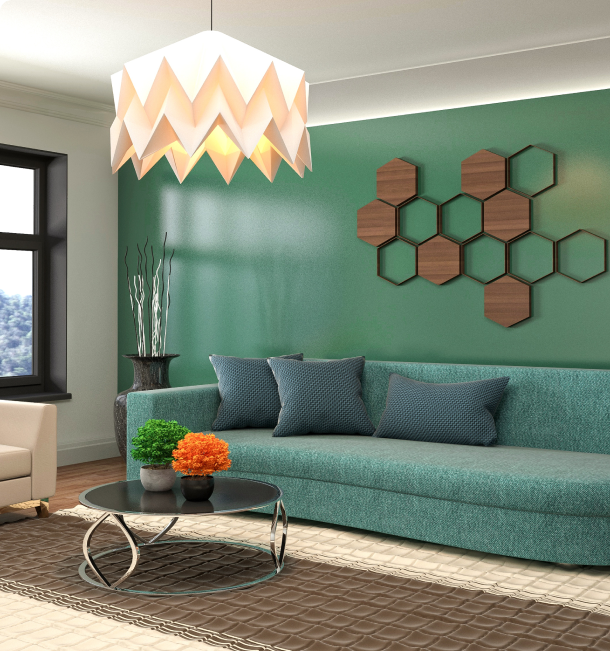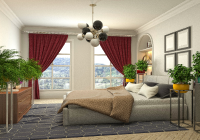
Introduction
The minimalist style of interior design is a powerful trend that has captivated homeowners and designers alike. Rooted in the principle of simplicity, this style emphasizes the use of clean lines, neutral color palettes, and functional furniture to create serene and uncluttered living spaces. At ArchVerse3D, we believe in the beauty of minimalism and its ability to transform any interior into a harmonious and aesthetically pleasing environment.
Origins of Minimalist Design
The minimalist design movement originated in the late 20th century, influenced by traditional Japanese design and the Bauhaus movement. It emerged as a reaction against the excesses of earlier design styles, promoting a return to the basics. The core philosophy revolves around the idea that “less is more,” advocating for the elimination of unnecessary elements and the focus on what truly matters.
Key Principles of Minimalist Interior Design
- Simplicity and Functionality
Minimalist design is characterized by its simplicity and functionality. Every piece of furniture and decor serves a purpose. The design is stripped of any superfluous elements, leaving only what is essential. This approach not only creates a clean and uncluttered look but also ensures that every item in the space is used and appreciated.
- Open Space and Natural Light
An essential feature of minimalist interiors is the use of open space and natural light. Large windows, open floor plans, and the absence of unnecessary walls or partitions help in creating an airy and spacious feel. Natural light enhances the simplicity of the design, highlighting the beauty of the few carefully selected elements within the room.
- Neutral Color Palettes
Minimalist interiors often feature neutral color palettes dominated by whites, beiges, grays, and other muted tones. These colors contribute to the tranquil and serene atmosphere typical of minimalist spaces. Occasionally, accents in darker shades or pops of color are used sparingly to create contrast and interest without overwhelming the simplicity of the design.
- Quality Over Quantity
In minimalist design, the focus is on quality rather than quantity. Fewer pieces are selected, but they are of higher quality and often serve multiple functions. This approach not only enhances the aesthetic appeal but also ensures durability and long-term satisfaction with the design choices.
Designing a Minimalist Space
- Declutter and Simplify
The first step in creating a minimalist interior is to declutter. This involves removing all unnecessary items and keeping only those that serve a purpose or hold significant value. Decluttering helps to clear both the physical and mental space, allowing for a more focused and serene environment.
- Choose Functional Furniture
Furniture in a minimalist space should be functional and devoid of excessive ornamentation. Pieces with clean lines, simple shapes, and neutral colors work best. Multi-functional furniture, such as a sofa that doubles as a bed or a coffee table with storage, is particularly useful in maintaining the minimalist aesthetic.
- Embrace Open Storage Solutions
Open storage solutions, such as shelves and wall-mounted units, help to keep the space organized while maintaining an open and airy feel. These storage solutions should be kept tidy and minimal, displaying only a few carefully curated items to avoid clutter.
- Incorporate Natural Elements
Adding natural elements, such as plants or wooden accents, can enhance the minimalist design by bringing warmth and a touch of nature into the space. These elements should be simple and unobtrusive, complementing the overall design without drawing too much attention.
- Focus on Lighting
Lighting is a crucial element in minimalist design. Natural light should be maximized wherever possible, using sheer curtains or blinds that can be easily adjusted. Artificial lighting should be simple and functional, with fixtures that complement the clean lines of the design. Recessed lighting, floor lamps, and pendant lights are all excellent choices for minimalist interiors.
Benefits of Minimalist Interior Design
- Enhanced Focus and Productivity
A clutter-free environment reduces distractions, allowing for better focus and productivity. This is particularly beneficial in home offices or study areas where concentration is essential.
- Easier Maintenance
Minimalist spaces are easier to clean and maintain due to the lack of clutter and unnecessary items. This simplicity not only saves time but also contributes to a healthier living environment.
- Timeless Aesthetic
The minimalist design is timeless and does not rely on trends that can quickly become outdated. This ensures that the space remains stylish and relevant for years to come, avoiding the need for frequent redecorations.
- Stress Reduction
A minimalist environment promotes a sense of calm and relaxation. The lack of clutter and the emphasis on simplicity help to create a peaceful atmosphere, reducing stress and enhancing overall well-being.
Incorporating Minimalism into Different Spaces
Living Room
A minimalist living room should feature a few carefully selected pieces of furniture, such as a sofa, coffee table, and shelving unit. The focus should be on creating a comfortable and functional seating area with plenty of open space. Neutral colors and natural light play a crucial role in enhancing the minimalist aesthetic.
Bedroom
In a minimalist bedroom, the bed is often the focal point. Simple bedding, a few pieces of functional furniture, and minimal decor create a serene and restful environment. Ample storage solutions help to keep the space tidy and clutter-free.
Kitchen
A minimalist kitchen emphasizes functionality and simplicity. Clean lines, open shelving, and neutral colors create a streamlined look. The use of high-quality materials and efficient storage solutions ensures that the kitchen remains practical and easy to maintain.
Bathroom
A minimalist bathroom features simple fixtures, neutral colors, and plenty of natural light. The focus is on creating a clean and relaxing space, free from unnecessary clutter. Functional storage solutions, such as built-in shelves and cabinets, help to keep the space organized.
Conclusion
The minimalist style of interior design offers a unique blend of simplicity, functionality, and aesthetic appeal. By focusing on what truly matters and eliminating unnecessary elements, minimalist interiors create serene and harmonious living spaces that enhance overall well-being. At ArchVerse3D, we embrace the principles of minimalism to help you create interiors that are not only beautiful but also timeless and functional.











Leave a Reply